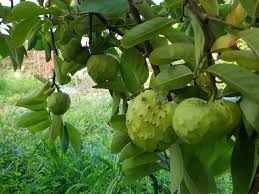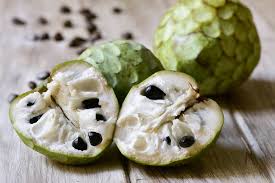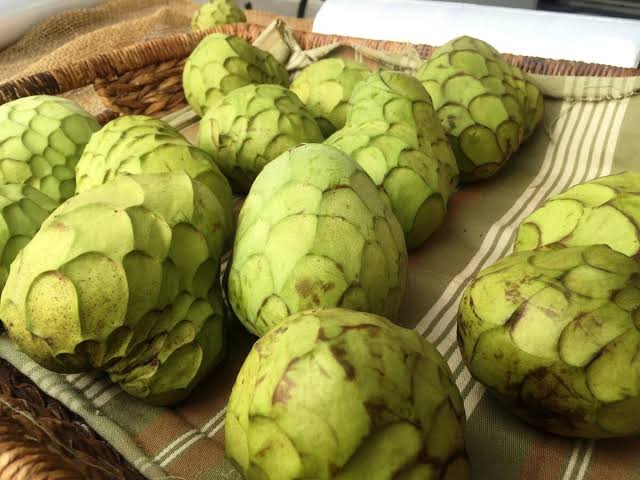Cherimoyas, scientifically known as Annona cherimola, are delightful tropical fruits celebrated for their sweet and custard-like taste. These green, heart-shaped wonders originate from the Andes region in South America but have found their way into various parts of the world due to their exceptional flavor.
These fruits boast a smooth, green skin with scales, hiding a soft, white, and creamy interior. The creamy flesh is studded with large, shiny black seeds that add a subtle crunch to each bite. Cherimoyas are often referred to as “custard apples,” reflecting their smooth and velvety texture, reminiscent of a delectable custard dessert.
One of the remarkable features of cherimoyas is their unique combination of flavors. The taste is a delightful blend of tropical notes, often described as a mix of banana, pineapple, and strawberry. This exotic fusion makes cherimoyas a favorite among fruit enthusiasts seeking a refreshing and satisfying treat.
Cherimoyas are not only known for their delicious taste but also for their nutritional benefits. They are a good source of vitamin C, providing a boost to the immune system, and they contain essential nutrients like potassium and dietary fiber, promoting overall health.
These fruits thrive in warm, subtropical climates and have adapted well to various regions, including parts of Asia, Africa, and the Mediterranean. Cultivating cherimoyas requires careful attention to soil conditions and temperature, making them a prized fruit in regions with suitable climates.
Harvesting cherimoyas requires patience, as they are typically picked when fully ripe. The fruit’s readiness is indicated by a slight yield to gentle pressure. Once harvested, cherimoyas are best enjoyed fresh, either by themselves or as part of a fruit salad.
Beyond their culinary uses, cherimoyas have found a place in traditional medicine. Some cultures believe in their potential to alleviate digestive issues and promote skin health. While scientific evidence supporting these claims is limited, the cultural significance of cherimoyas in different regions highlights their diverse appeal.
In addition, cherimoyas, with their scientific name Annona cherimola, are more than just tropical fruits – they are a sensory delight, captivating taste buds with their luscious texture and unique flavor profile. Whether enjoyed fresh or incorporated into various dishes, cherimoyas continue to enchant people worldwide, leaving a lasting impression as a cherished and flavorful fruit.
Read Also: Problems or Constrains of Rabbit Production
The History of Cherimoyas

The history of cherimoyas is rooted in the ancient civilizations of the Andes region in South America. Indigenous to the high-altitude areas of Peru, Ecuador, and Colombia, cherimoyas have a rich cultural and historical significance dating back centuries.
Ancient Inca and pre-Inca civilizations revered cherimoyas as a symbol of fertility and vitality. The fruit’s cultivation and consumption were intertwined with rituals and ceremonies, reflecting its importance in the daily lives of these early societies.
With the Spanish colonization of South America in the 16th century, cherimoyas caught the attention of European explorers and settlers. The unique flavor and appearance of the fruit intrigued them, leading to its introduction to other parts of the world.
Cherimoyas gradually spread to regions with suitable climates, including parts of Asia, Africa, and the Mediterranean. The adaptability of the fruit to diverse environments contributed to its successful integration into various cultures and cuisines.
In the 19th century, cherimoyas gained popularity in the United States, particularly in California, where they found a hospitable climate for cultivation. Orchards were established, and the fruit became a sought-after delicacy.
Over the years, cherimoyas have become a global sensation, appreciated for their delectable taste and versatility. The fruit’s journey from the Andes to different corners of the world is a testament to its ability to transcend cultural boundaries and captivate the palates of people from diverse backgrounds.
Today, cherimoyas continue to be a cherished fruit, celebrated not only for their historical roots but also for their contribution to the culinary landscape worldwide. As part of the broader narrative of agricultural exchange and exploration, cherimoyas stand as a flavorful reminder of the interconnectedness of cultures and the rich history that accompanies the fruits we enjoy today.
The Nutritional Values of Cherimoyas

Cherimoyas are not only a delightful treat for the taste buds but also offer a range of nutritional benefits. Packed with essential nutrients, these tropical fruits contribute to a well-balanced and healthy diet.
1. Vitamin C: Cherimoyas are a good source of vitamin C, a powerful antioxidant that supports the immune system. This vitamin plays a crucial role in protecting cells from damage and promoting overall health.
2. Potassium: Rich in potassium, cherimoyas contribute to maintaining proper heart and muscle function. Potassium is essential for regulating blood pressure and fluid balance in the body.
3. Dietary Fiber: Cherimoyas contain dietary fiber, which aids in digestion and helps prevent constipation. Including fiber in the diet is important for maintaining a healthy digestive system.
4. B Vitamins: Cherimoyas provide various B vitamins, including B6, which is essential for brain development and function. These vitamins play a role in energy metabolism and the formation of red blood cells.
5. Minerals: Apart from potassium, cherimoyas contain other essential minerals like magnesium, manganese, and copper, which contribute to various physiological functions in the body.
6. Calories: Cherimoyas are relatively low in calories, making them a healthy snack option. The fruit’s natural sweetness satisfies cravings without the need for added sugars.
7. Folate: Cherimoyas contain folate, a B-vitamin important for DNA synthesis and repair. Adequate folate intake is especially crucial during pregnancy for the proper development of the fetus.
Incorporating cherimoyas into your diet can be a flavorful way to enhance your nutrient intake. Whether enjoyed on their own, added to fruit salads, or used in creative culinary creations, cherimoyas offer a tasty and nutritious addition to a well-rounded eating plan.
Read Also: The Different Breeds of Rabbits
Health Benefits of Cherimoyas

Cherimoyas offer a range of health benefits, making them a valuable addition to a balanced diet. Here are some of the potential health advantages associated with consuming cherimoyas:
1. Immune System Support: Cherimoyas are rich in vitamin C, a powerful antioxidant that plays a crucial role in supporting the immune system. Adequate vitamin C intake may help the body defend against infections and illnesses.
2. Heart Health: The potassium content in cherimoyas contributes to maintaining healthy blood pressure levels and supporting cardiovascular health. Potassium helps regulate the balance of fluids and electrolytes in the body, reducing the risk of hypertension.
3. Digestive Health: The dietary fiber in cherimoyas promotes healthy digestion by preventing constipation and supporting regular bowel movements. Fiber also contributes to a feeling of fullness, which can aid in weight management.
4. Antioxidant Properties: Cherimoyas contain various antioxidants, including vitamin C and other phytochemicals, which help combat oxidative stress in the body. Antioxidants play a role in neutralizing free radicals, potentially reducing the risk of chronic diseases.
5. Bone Health: Cherimoyas provide essential minerals like calcium, magnesium, and phosphorus, contributing to overall bone health. These minerals are vital for maintaining strong and healthy bones.
6. Folate for Pregnancy: The presence of folate in cherimoyas is important, especially for pregnant women. Adequate folate intake is associated with a lower risk of neural tube defects in developing fetuses.
7. Weight Management: Cherimoyas are low in calories and high in fiber, making them a satisfying and healthy snack option. Including fruits like cherimoyas in a balanced diet can support weight management goals.
8. Skin Health: The antioxidants and vitamin C in cherimoyas may contribute to healthier skin by promoting collagen synthesis and protecting against damage caused by free radicals.
It’s essential to note that while cherimoyas offer these potential health benefits, a varied and balanced diet, along with a healthy lifestyle, is key to overall well-being. Individual responses to dietary components can vary, so it’s advisable to consult with a healthcare professional or nutritionist for personalized advice.
How to Grow Cherimoyas (Growing Guide)
Growing cherimoyas requires attention to specific conditions to ensure a successful cultivation process. Here’s a basic guide for growing cherimoyas:
1. Climate: Cherimoyas thrive in subtropical to mild-temperate climates. They prefer temperatures between 32°F to 100°F (0°C to 38°C). Frost can damage the plants, so it’s crucial to avoid areas with prolonged cold spells.
2. Soil: Choose well-draining soil with a slightly acidic to neutral pH (6.5 to 7.5). Sandy loam or loamy soil works well. Good drainage is essential to prevent waterlogging, which can be detrimental to cherimoyas.
3. Planting: Plant cherimoya seeds or seedlings in spring when the soil has warmed up. Ensure proper spacing, allowing each tree enough room to spread its branches as it grows. Dig a hole slightly larger than the root ball when planting seedlings.
4. Watering: Cherimoyas need regular watering, especially during dry periods. However, they are sensitive to waterlogged conditions, so the soil should be allowed to dry out between watering.
5. Fertilization: Apply a balanced, slow-release fertilizer during the growing season. Cherimoyas benefit from a nutrient-rich soil, but excessive fertilizer should be avoided.
6. Pruning: Prune cherimoya trees to encourage a strong structure and remove any dead or damaged branches. Regular pruning helps maintain the shape and size of the tree.
7. Pollination: Cherimoyas are often self-pollinating, but hand pollination can increase fruit production. Gently brush the pollen from the male flowers onto the female flowers using a small brush or cotton swab.
8. Harvesting: Cherimoyas are ready for harvest when they slightly yield to gentle pressure. Harvest by cutting the stem above the fruit. Allow harvested fruits to ripen at room temperature.
9. Pests and Diseases: Keep an eye out for pests such as aphids and caterpillars. Neem oil or insecticidal soap can be used for control. Cherimoyas are susceptible to fungal diseases, so proper air circulation and avoiding overhead watering help prevent issues.
10. Support: Young cherimoya trees may benefit from staking to provide support until they establish a strong root system.
11. Patience: Cherimoya trees can take a few years to start producing fruit. Be patient and provide consistent care to ensure a healthy and productive tree.
Read Also: Exploring The Tips and Benefits Of Fitness Classes
